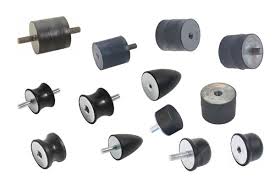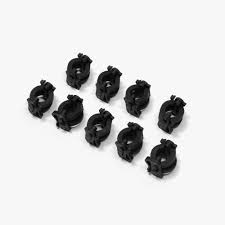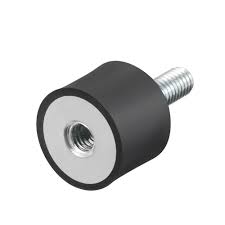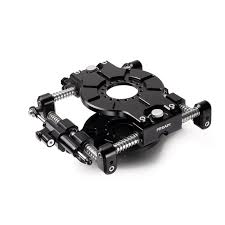Seismic Vibration Isolators: Protect Your Building with Advanced Technology Seismic events and vibrations can pose serious threats to the structural integrity of buildings. To address this concern, seismic vibration isolators have been developed to protect buildings from potential damage caused by earthquakes, heavy machinery, or other sources of vibrations. These isolators utilize advanced technology to effectively mitigate the impact of seismic forces, ensuring the safety and stability floor mount vibration isolators of the building. In this article, we will explore the importance of seismic vibration isolators and how they can safeguard your building from potential disasters.
Seismic vibration isolators are devices designed to protect buildings from the damaging effects of seismic base isolation seismic activity. These isolators are typically installed between a building's foundation and superstructure to absorb and dissipate the energy generated by ground motion during an earthquake. By effectively isolating the building from the ground's movement, seismic vibration isolators can significantly reduce the transmission of seismic forces, minimizing structural damage and enhancing the overall safety of the building. Different types of seismic vibration isolators are available, including elastomeric bearings, sliding bearings, and friction pendulum systems, each offering unique advantages in terms of cost, performance, and maintenance. Properly designed and installed seismic vibration isolators can help safeguard buildings and their occupants during seismic events, making them an essential component of seismic retrofitting and new construction in earthquake-prone areas.
Seismic vibration isolators are devices used to safeguard buildings from the destructive impact of seismic activity. They are installed between a building's foundation and superstructure to absorb and dissipate the energy generated by ground motion during an earthquake. By isolating the building from the seismic isolation bearings ground's movement, seismic vibration isolators can significantly reduce the transmission of seismic forces, minimizing structural damage and enhancing the overall safety of the building. Different types of seismic vibration isolators, such as elastomeric bearings, sliding bearings, and friction pendulum systems, are available, each offering unique advantages in terms of cost, performance, and maintenance. Properly designed and installed seismic vibration isolators are critical for safeguarding buildings and their occupants during seismic events, making them an essential component of seismic retrofitting and new construction in earthquake-prone areas.
The Importance of Seismic Vibration Isolators in Building Structures
hvac vibration isolators residential

Seismic vibration isolators are crucial components in building structures, especially in areas prone to earthquakes. These devices help absorb and dampen the strong oscillations and vibrations caused by seismic activity, thus protecting the building and its occupants from potential damage and harm. Seismic vibration isolators work by decoupling the building from the ground motion, allowing the structure to move independently of the shaking ground. This helps reduce the transfer of seismic forces and vibrations into the building, effectively minimizing structural damage and ensuring the safety of inhabitants. Incorporating seismic vibration isolators into building designs is particularly important for critical infrastructure such as hospitals, emergency response centers, and essential facilities, where operational continuity during and after an earthquake is paramount. Additionally, modern building codes and standards often require the use of seismic isolation technologies in regions with high seismic activity to enhance overall structural resilience and protect human life. By incorporating seismic vibration isolators into building structures, engineers and designers are able to mitigate the impact of seismic events, ultimately contributing to safer and more robust construction practices in earthquake-prone areas.
Types of Seismic Vibration Isolators and Their Applications

Seismic vibration isolators are devices that are used to protect buildings and equipment from the damaging effects of earthquakes and other ground vibrations. There are several types of seismic vibration isolators, including elastomeric isolators, sliding isolators, and friction pendulum isolators. Elastomeric isolators consist of rubber and steel components that absorb and dissipate seismic energy. They are commonly used in buildings and bridges to minimize the impact of ground motion on structures. Sliding isolators utilize sliding surfaces to isolate the building or equipment from the ground motion, while friction pendulum isolators use the principle of pendulum motion to reduce seismic forces. These isolators are used in a variety of applications, including seismic retrofitting of existing buildings, new construction in seismically active areas, and protection of critical equipment such as data centers, hospitals, and manufacturing facilities. By incorporating seismic vibration isolators into building and equipment design, the risk of damage and downtime due to seismic events can be significantly reduced.
How Seismic Vibration Isolators Protect Equipment and Machinery

Seismic vibration isolators protect equipment and machinery by absorbing and dissipating the vibrations and shocks caused by seismic activity. These isolators are designed to minimize the transmission of ground motion to the equipment, thereby protecting it from potential damage. By isolating the equipment from the ground vibrations, seismic vibration isolators help maintain the functionality and integrity of critical machinery during seismic events. This can be particularly crucial in industries such as manufacturing, power generation, and healthcare where the continuous operation of equipment is essential.
Choosing the Right Seismic Vibration Isolators for Your Needs

Choosing the right seismic vibration isolators for your needs involves considering various factors such as the size and weight of the equipment requiring isolation, the level of vibration and shock to be mitigated, and the specific environmental conditions of the installation site. It is important to select isolators that are designed to handle the anticipated loads and provide the necessary level of isolation performance. Additionally, factors such as the installation space and maintenance requirements should also be taken into account when choosing the right vibration isolators for your application. Consulting with a qualified engineer or vibration control specialist can help ensure that the most suitable isolators are selected for your specific needs.
The Role of Seismic Vibration Isolators in Earthquake-Prone Areas
Seismic vibration isolators are crucial components in buildings located in earthquake-prone areas. These isolators help to mitigate the effects of seismic activity by absorbing and dissipating the energy caused by ground motion. By isolating the building from the ground motion, these devices reduce the transfer of seismic forces to the structure, thus minimizing the potential for damage. There are several types of seismic vibration isolators, including base isolators, which are installed between the building and its foundation, and supplemental damping systems, which absorb energy through viscous or frictional materials. These isolators are designed to enhance the overall seismic performance of structures, making them more resilient to earthquakes. In earthquake-prone areas, the implementation of seismic vibration isolators is a critical aspect of structural engineering and building design. These devices can significantly improve the safety and stability of buildings, ensuring that they can withstand the impact of seismic events and protect the lives of occupants. As such, seismic vibration isolators are an essential consideration for construction projects in regions at risk of earthquakes.
Innovations in Seismic Vibration Isolator Technology
Innovations in seismic vibration isolator technology have led to the development of advanced systems that can effectively protect structures from earthquake-induced vibrations. These isolators are designed to minimize the transfer of seismic energy to buildings, bridges, and other infrastructure, thus reducing the likelihood of structural damage and collapse during an earthquake. One notable innovation in seismic vibration isolator technology is the use of versatile materials such as high-damping rubber and other elastomeric compounds, which provide enhanced energy dissipation and durability. These materials are integrated into various types of seismic isolators, including base isolators, friction pendulum systems, and elastomeric bearings, to effectively mitigate the impact of ground motion on structures. Furthermore, advancements in design and manufacturing processes have allowed for the development of customizable seismic isolator solutions that can be tailored to specific project requirements and performance goals. This flexibility enables engineers and designers to optimize the performance of seismic isolation systems for a wide range of applications, from new construction projects to retrofitting existing structures. Overall, ongoing innovations in seismic vibration isolator technology continue to improve the resilience of buildings and infrastructure in earthquake-prone regions, helping to enhance public safety and minimize the potential impact of seismic events.
Maximizing the Effectiveness of Seismic Vibration Isolators
To maximize the effectiveness of seismic vibration isolators, it is essential to consider several factors. These include the type and size of the isolators, the materials used, the weight and distribution of the equipment being isolated, and the frequency and amplitude of potential seismic vibrations. Properly installing and maintaining the isolators is also crucial for ensuring their effectiveness. Additionally, conducting regular assessments and potentially upgrading isolators as needed can further enhance their performance.
Seismic Vibration Isolators: Ensuring Safety and Stability in Structures
Seismic vibration isolators are devices used to protect structures from the damaging effects of earthquakes and other ground vibrations. These isolators are designed to absorb and dissipate the energy generated by seismic events, thereby reducing the impact on the structure and ensuring its safety and stability. These isolators typically consist of a combination of springs, dampers, and bearings that work together to minimize the transmission of seismic forces to the building. By isolating the structure from the ground motions, these devices help to prevent structural damage and potential collapse during an earthquake. Seismic vibration isolators are commonly used in a variety of structures, including buildings, bridges, and industrial facilities. They can be installed during the construction phase of a new structure or retrofitted into existing buildings to improve their seismic performance. Overall, seismic vibration isolators play a crucial role in safeguarding structures and their occupants during seismic events, making them an essential component of earthquake-resistant design and construction.
In conclusion, implementing seismic vibration isolators is crucial in protecting your building from potential damage and ensuring the safety of its occupants. By effectively dissipating and isolating the energy generated by seismic events, these isolators can significantly reduce the impact of vibrations and protect the structural integrity of the building. Investing in seismic vibration isolators is a proactive measure that can provide peace of mind and long-term protection for your property.
See also
https://www.acecontrols.com/us/products/vibration-isolation.html https://www.vibrationmounts.com/ https://www.rticontrols.com/vibration-isolation